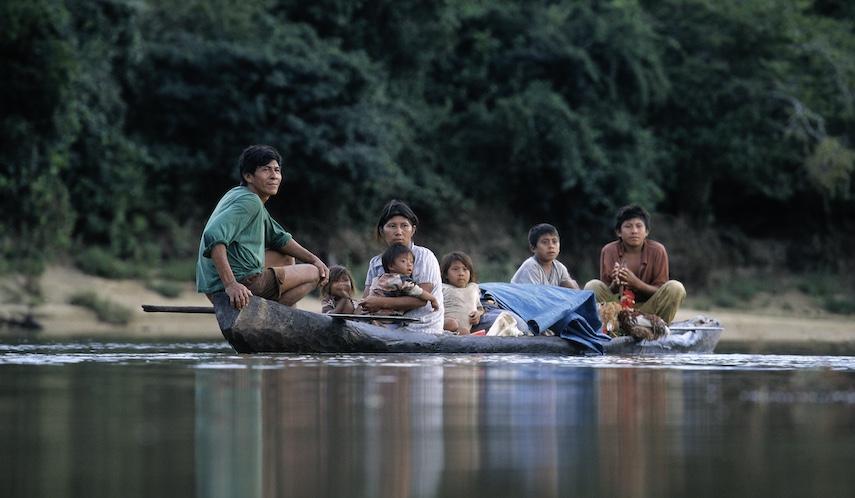
Indigenous family in a dugout canoe on the Essequibo River running through Guyana’s Iwokrama Rainforest. Photo courtesy of FotoNatura
By Anietra Hamper
The bifurcating channels of the Essequibo River that wind through Guyana’s Iwokrama rainforest are nature’s highways into the deepest, densest and most remote part of the jungle. Macushi Amerindian Mark Andries navigates this complex matrix of waterways searching for Hoplias aimara, more commonly referred to as the wolf fish. For Guyana’s indigenous people, the wolf fish is akin to caviar. For visiting anglers from around the world seeking Andries’ guidance, catching the ferocious freshwater predator is a bucket-list experience.
The textured face of the wolf fish appears almost mangled featuring teeth that mimic barbed wire and oversized black marble eyes that give it a keen ability to see clearly in the deep, dark pools of water. These defense mechanisms enable the wolf fish to defend itself against the unforgiving black piranha and other species that compete for survival in these narrow waterways.
These fish are difficult to catch and even more difficult to find which is why natives like Mark are essential to Guyana’s destination fishing economy.
Ian Henderson is one of four anglers who traveled to these remote waters from Great Britain. As an accomplished international fishing guide and owner of Ian Henderson Guiding in the UK, he makes return trips to the Essequibo River, each time relying on Andries’ native insight to navigate the waterways.
Anglers generally come in groups of two to twelve for at least 10 days at a time. With two anglers to a boat heading to various sections of the river each day they rarely see another person during their stay except for each other in the evenings at the lodge.
As Mark paddles quietly through the tight channels, the surrounding space narrows with every stroke forward. Hundreds of years of submerged trees and petrified logs lie just beneath the surface making safe dens for the wolf fish which shelter silently until they are ready to ambush passing prey.
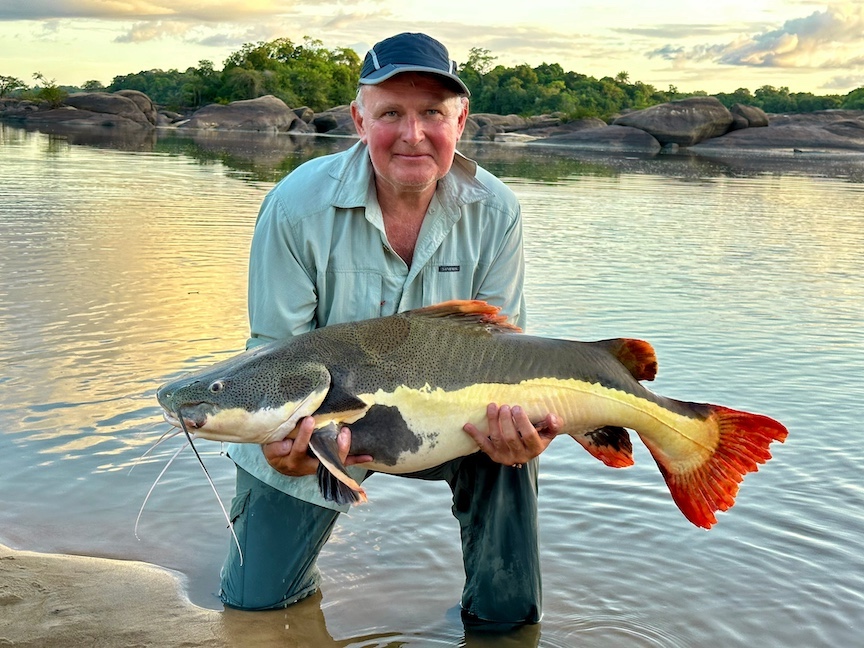
British angler and fishing guide Ian Henderson with a Redtail catfish. He believes the whole Amazon fishing experience makes him reflect on life at a deeper level. “Each time I come here, the desire to return becomes even stronger,” he says. Photo by Anietra Hamper
The jungle stirs mixed emotions in outsiders who are equally haunted and fascinated by the way of life existing so organically in this hidden place in the jungle.
“The anticipation of the wolf fish never gets old,” says Henderson. “It’s like watching a suspenseful movie for the tenth time, knowing what’s going to happen, but it still jolts you to the core when it does.”
We slowly make our way upriver surrounded by dense jungle walls on both riverbanks. The Greenheart and Crabwood forests through which we pass are in various stages of growth and disintegration. Towering trees can fall at any moment, disrupting the rainforest’s apparent serenity with thundering cracks that shoot shockwaves through the narrow river channels.
When nature settles, the air stills into a muted asphyxiating heat that hovers below the jungle canopy.
Life Astride the Jungle Canopy
“I see bubbles,” Mark says in a whisper doing his best to articulate in broken English. His palms-down gesture lets anglers know to remain silent so as not to alert the ravenous wolf fish that live in these pools.
Bubbles indicate fish. It’s one of the signs that Mark looks for as he carefully weaves the aluminum boat through a maze of shallow channels that are difficult to navigate due to a recent drought.
“This is the wolf fish house. Drop your line here and let the bait rest on the bottom,” Mark says in a monotone voice.
Fresh-cut piranha chunks splash into the pool of still water. It’s an audible addition to nature’s cacophony of sounds of red howler monkeys leaping through the treetops, macaws screeching overhead in piercing decibels and the commotion of a nearby caiman taking down fresh prey.
We anxiously await the strike of the wolf fish. When it takes the bait a fishing line will snap with the force of a car crash. Unprepared anglers can suffer a whiplash. It t seems unrealistic that a freshwater fish can hit with such force, but the wolf fish strike is brutal.
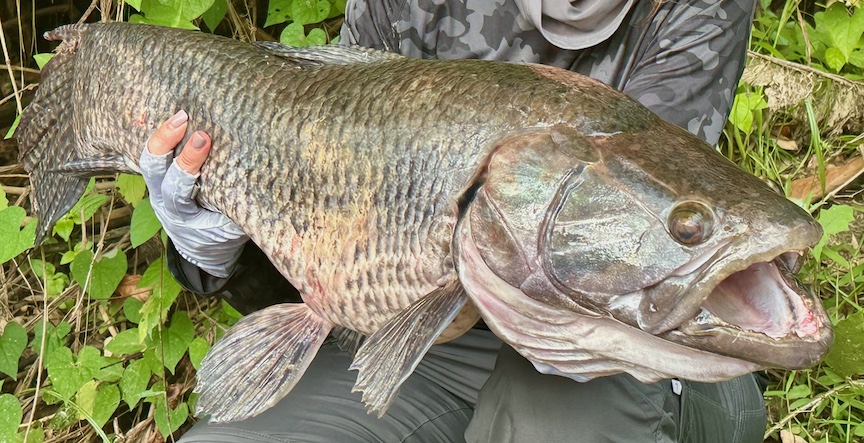
This Wolf Fish fought mightily to stay in the river. Photo by Anietra Hamper
Why do anglers choose to travel such long distances and go deep into the rainforest with native Amerindians like Mark to seek out the wolf fish?
It’s about more than catching fish. It is about experiencing a thriving primitive world that exists independent of any modern-day technology or conveniences.
Anglers in Paradise
While rivers in Europe offer anglers monster species like the wels catfish (Silurus glanis) and remote Indian waters hold the prized golden mahseer (Tor putitora), the Essequibo River in Guyana is in a league of its own.
This small country with a population of approximately 800,000 is bordered by Venezuela, Brazil, and Suriname. It is a nation comprised of people from six races, multiple religions and nine indigenous tribes. It is a complex balance of modern and primitive traditions and cultures of its native people who still live as they have for thousands of years.
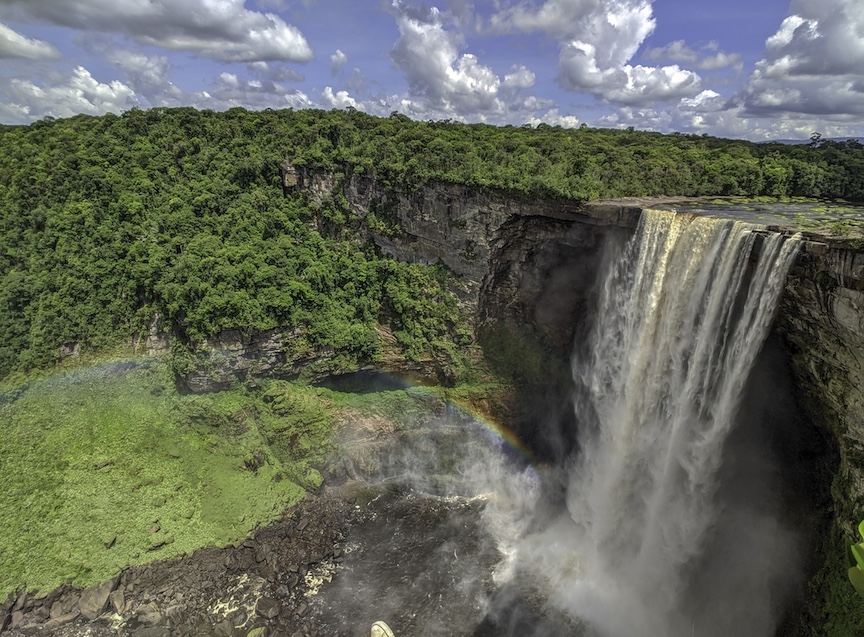
When the midday sun is shining brightly, visitors to Kaieteur Falls usually see a rainbow extending from the roaring curtain of water. Photo courtesy of Tourism Guyana
While many travelers enjoy the hip Caribbean atmosphere of the capital of Georgetown, others seek out Guyana’s more untouched treasures like Kaieteur Falls, the world’s largest single-drop waterfall, the giant anteater in the Rupununi savannah, the jungle wildlife hallmarked by jaguars and anacondas and the remote rainforest where anglers go for their slice of fishing nirvana.
The Essequibo River flows more than 600 miles allowing anglers to target many species. Anglers can go into the rainforest hoping to catch a prized piraiba catfish and instead experience the unforgettable body shock and muscle pulls of the angry wolf fish hitting their line.
Other prized catch and release species that draw anglers include the 400-plus pound prehistoric arapaima or pirarucu (Arapaima gigas), vampire fish or payara (Hydrolycus scomberoides), the bucket-list Jau (Zungaro zungaro) and redtail catfish (Phractocephalus hemioliopterus).
These unique species are each equipped with unique defense and survival mechanisms. The jagged razor teeth of the black piranha are capable of biting through a steel line and the armored scales on the arapaima can knock out anglers with a single whip of its body and a tail lash that mimics the sound of a gunshot. Guyana is the ultimate multi-species fishing destination.
Journey into the unknown
Anglers seeking unique fishing experiences in Guyana enjoy the journey into the rainforest which can take two or three days of travel.
To outsiders, the Iwokrama rainforest is like a real-life Chronicles of Narnia. Instead of a door located inside a secret wardrobe serving as a portal to a fantastical world, anglers arrive on a 13-seater prop plane from the capital of Georgetown, flying over a vast rainforest and landing on a dirt airstrip in the middle of a village called Fairview.
To the Guyanese, the small plane is a taxi service into the interior rainforest regions of the country. The locals are unphased by the cramped space where nearly anyone can speak to the pilot. This form of transportation is considered a luxury to those who can afford it compared to travel by dirt roads that are often blocked due to heavy rainfall which can make the journey long and unpredictable.
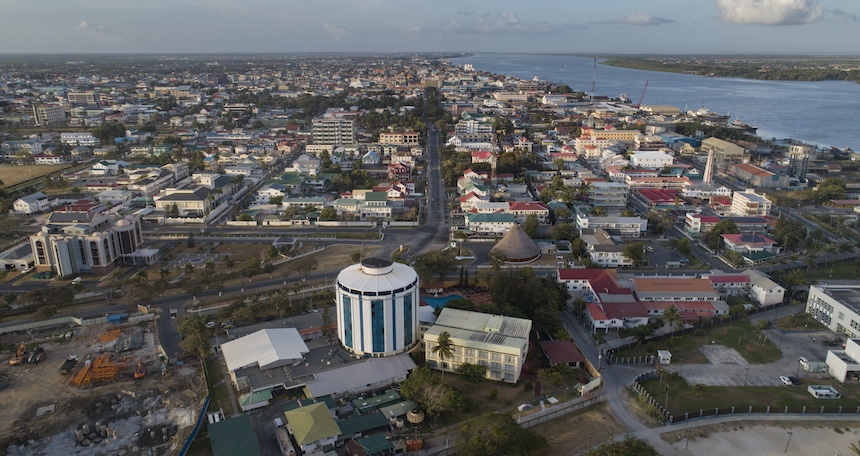
Aerial view of Guyana’s capital of Georgetown. Photo by Deonarine Chand
When the plane departs from Georgetown the brilliant Caribbean colors of the buildings below are the last semblance of modern life that anglers will see for weeks. Homes and buildings slowly evolve into hundreds of shades of green as the rainforest comes into view interrupted only by an occasional waterfall or small village huts during the hour-long flight.
There is a hypnotic effect on seeing the rainforest from the air. From above, it resembles hundreds of miles of broccoli florets and makes anglers aware of the vast differences between where they came from and what lies ahead.
The landing on the truncated dirt airstrip in the sparsely populated Fairview village serves as the abrupt welcome to the next part of the journey. Here is where anglers are introduced to Mark Andries and the Amerindian way of life as they walk their luggage and fishing gear past people peering from small huts to the small boat waiting for them on the riverbank.
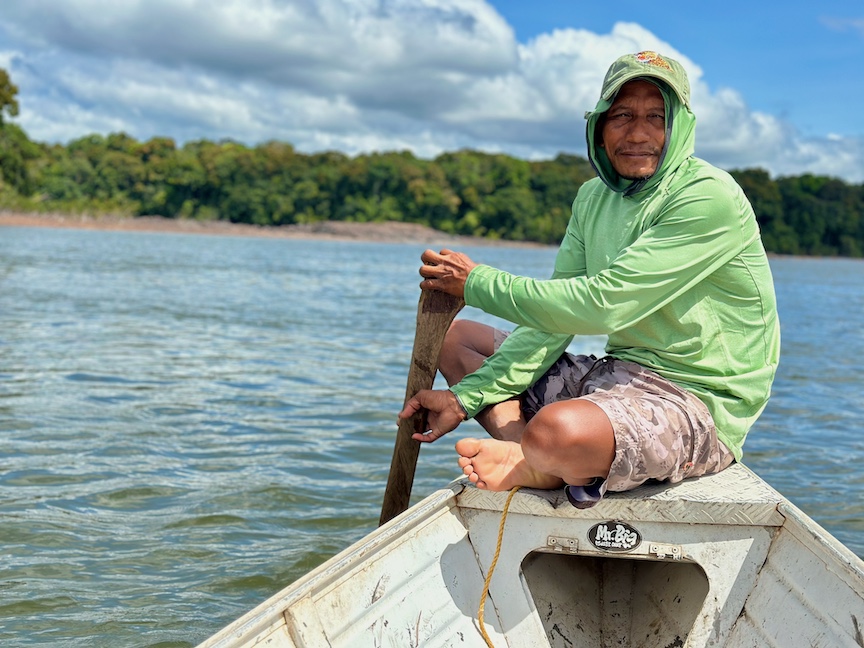
Amerindian fishing guide Mark Andries keeps anglers safe during their journey through the Iwokrama rainforest on the Essequibo River. Photo by Anietra Hamper
It’s midday when Henderson and three other anglers arrive. As they make their way down the singular dirt path leading to the river, they pass a group of villagers gathered beneath a shade tree doing daily chores. Their tanned leathered skin and callused hands reveal a lifetime of physical daily work in the intense Guyanese sun.
“These are my cousins. They are cutting cassava,” Mark says. Brief smiles are exchanged without a moment of disruption to their rhythmic cutting of cassava. The few villagers in the area are used to seeing occasional visitors from the UK, United States, Germany, Eastern Europe and elsewhere around the world who pass through on their way to fish on the Essequibo River.
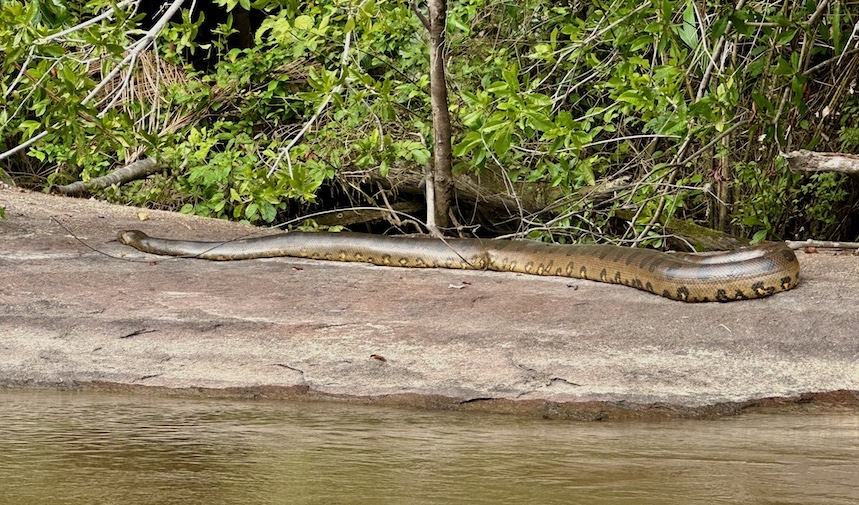
Anaconda takes an afternoon nap on a warm rock next to the river. Photo by Anietra Hamper
The nearly two-hour journey into the heart of the rainforest is an instant immersion into the nature and wildlife that defines the rainforest. The scenery can range from a post downpour rainbow to anacondas sunning on rocks, or a family of giant river otters on the prowl.
Welcome to nature’s home
Anglers spend 10-12 hours a day on the river with their guides in a small boat. They also interact with the local cooks at the lodge who prepare meals over an open fire using traditional recipes for delicacies like armored catfish and Guyanese pepper pot. Fishing in the protected Iwokrama rainforest operates under a protocol of catch and release with the sole exception of keeping a small eating-size fish for an occasional meal.
Andries is a fishing guide for Adventure Guianas, a company that offers fishing and nature trips to domestic and international visitors. Anglers rely on Mark’s knowledge to experience the fishing trip of a lifetime. He was born and raised on the Essequibo River and knows every rapid, boulder and channel because it is the only means of travel for villagers who live on this vast waterway.
The Iwokrama rainforest is a sacred place – almost like a living fairytale. Electric blue butterflies swarm and hover in rhythmic movements over the rapids while tiny yellow ones flutter in sync forming small tornadoes around the sandbars exposed from the low water level.
The visible elements of the Essequibo are exciting, but the greater fascination is the nature and wildlife that cannot be seen like the howler monkeys hidden under the jungle canopy and their loud haunting synchronized in a loud haunting chorus that reverberates.
When night falls in the jungle, sounds are the only signature of creatures like bats making their presence known by the flapping of their wings or the slight rustling of leaves from a stealthy jaguar on the prowl.

Welcome to the Neighborhood. The fish on the left is so primitive some anglers just call it “the historic-looking fish.” Holding down the middle spot is the prickly Vampire Fish. Last but not least is the Jau Catfish. Photos by Anietra Hamper
While Mark can only point out things like the “red-headed bird,” “whale pig” (big pig) or “hair-cutting bee” in descriptive terms, he is intimately connected to nature through a mesmerizing symbiotic relationship.
Amerindians living in the jungle wear no watches, and yet they know the exact time of day. “I know by nature’s timepiece,” Mark says, referring to how he always knows that it is noon – on the dot – when he breaks out the packed lunches or 4 p.m. when he packs the boat for departure knowing his guests will be back to the lodge by sunset.
Mark’s presence is always calm and neutral. He offers the same smile and blank expression in moments of excitement when anglers catch their sought-after fish as he does when they experience a disappointing loss. No amount of worry or exuberance changes the steady pace of daily life.
Fishing as a way of life
When Andries is not guiding anglers, he mines for gold. It is a difficult and erratic way to make a living but given Guyana’s rich natural resources, it is a common side hustle for many of the men born in the rainforest.
“I am like a pig,” Mark says describing the mining conditions. “I mine for many months to find gold. If I find some, I will get a little bit of money. If I find none, I go home with no money.”
It’s dirty, exhausting, and dangerous. Mark nearly died after catching malaria during a recent stint sleeping in the mines where he sometimes works for several months when he is not guiding anglers on the Essequibo River.
This is why guiding is important work for Mark and the other local guides. It leverages their skills and expertise on the river while giving them a sustainable income that filters back into their local communities. He also shares his culture and native lifestyle since fishing is so deeply rooted in his way of life.
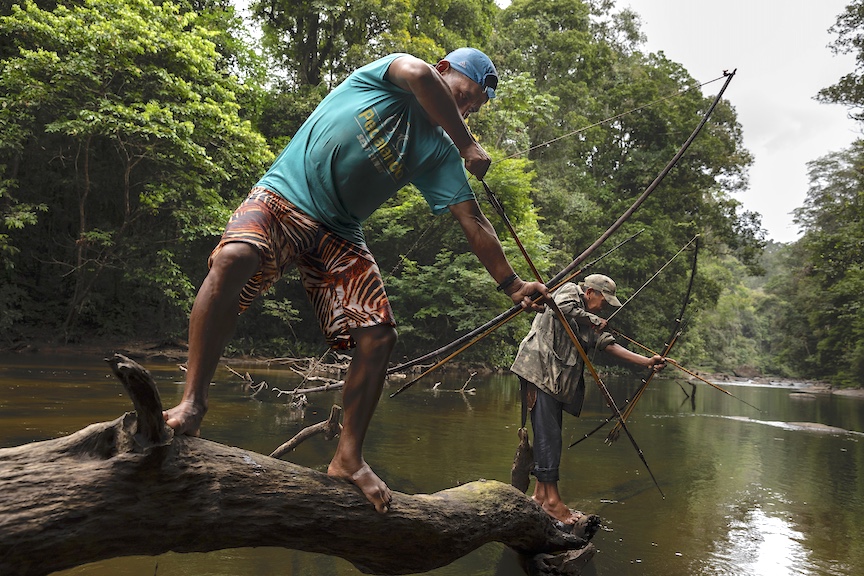
Leon Baird,32, and 63-year-old Herman Phillips (on right) are indigenous Guyanese who feed their families from the rivers and forests around where they live. Photo by SWM
“We use hand line or a bow and arrow to shoot fish,” Mark says when asked how the indigenous people fished long before anglers arrived with modern tackle and fishing rods that are often left for him to keep and use.
Andries is fascinated by what he considers lavish fishing gadgets that visiting anglers bring with them. While he doesn’t dispute that modern lures and reels can make fishing easier, he nevertheless laughs on occasion at anglers’ need to use expensive tools when the natives have used primitive methods, even for large fish, for centuries.
A remote culture in modern times
Being isolated from the outside world means that modern conveniences like Wi-Fi and even chocolate are unfamiliar to many Amerindians. Also missing is a large part of the jungle interior’s oral history.
After Guyana’s independence from Britain in 1966 many schools were eliminated. Even those schools that did remain open deemphasized instruction in indigenous languages and customs well into the first decade of this century. As a result, Mark and many people in his generation have no formal education and are unable to speak the Macushi language. Cultural practices also eroded.
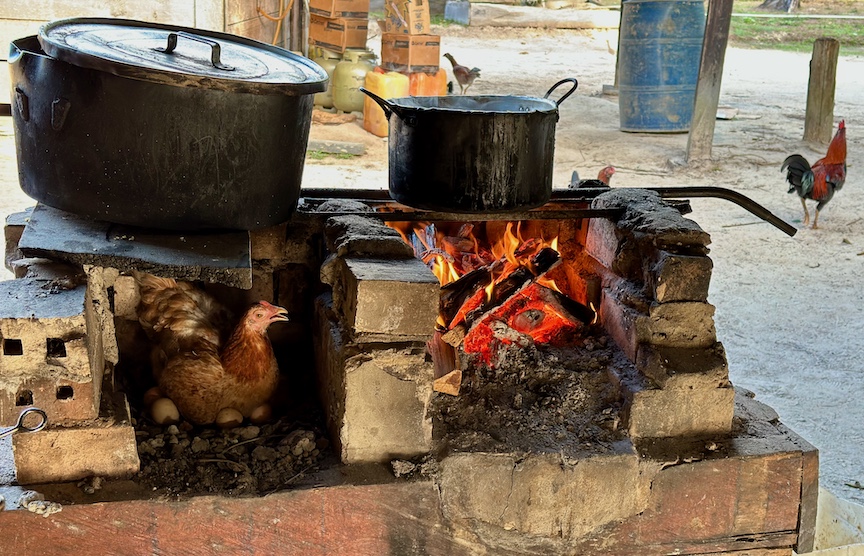
Guyanese Amerindians cook food for fishermen over an open flame near where a resident chicken finds a comfortable roost for eggs. Photo by Anietra Hamper
The Amerindian culture and language are reemerging with help from non-governmental organizations and conservation groups that are now active in Guyana. Most communities now have schools and additional resources exist to protect and teach the traditional culture and language.
For middle-aged Amerindians like Andries, survival and foundational existence come from instincts. This is why his communication is simple and his instruction to anglers is only in the form of basic phrases like, “rest the bait,” and “let’s go into the shadow,” when he boats anglers to a shady spot to get out of the intense heat of the sun.
Mark now lives in the Rupununi region which has the largest concentration of indigenous Amerindian people, but he frequents the rainforest where he was born and where his mother still lives on an island.
While education and culture are making a comeback in remote regions of Guyana, there is still a vacuum when it comes to communication and news of current events. Many people in the tribal regions do not have phones or internet so they rely on second-or-third-hand information oftentimes coming from relatives who heard it from someone else who found it on social media. Guyanese like Mark do not have access to information from credible news sources.
This sporadic and disjointed dissemination of information becomes a dangerous version of the childhood game of telephone in which facts become entangled with gossip and then re-presented as truth repeatedly. It negatively impacts the quality of life for people like Mark who rely on word-of-mouth for outside information.
The most recent example is the rekindling of a longstanding border dispute between Guyana and Venezuela over the Essequibo region, which covers approximately two-thirds of the country. Political talks and posturing began after Venezuelans approved a referendum in 2023 for the government to claim sovereignty of the region in a bid for Guyana’s oil and mineral-rich resources. Despite the referendum’s approval, both sides agreed to avoid escalating tensions and decided instead to continue the dialogue.
A Lasting Impact
The Iwokrama rainforest is protected land that was given by the Guyanese government to the international community to show that a rainforest could be developed sustainably. According to the Iwokrama Rainforest Reserve, there are only four tropical rainforests in the world and those in the Amazon, Congo and New Guinea are much better known than the Iwokrama.
The rainforest is a special place that protects and preserves this indigenous culture and the people and wildlife that depend on it. For the anglers who get the rare opportunity to visit this jungle environment, it is a gift.
While boating out of the rainforest in a rewind moment from their arrival, anglers spend the two-hour trip in a contemplative state evaluating the dynamic contrast of life between the rainforest and home. The disparity of existence is profound: the conveniences and materialism in the modern world compared to the simplistic indigenous way of life and the people like Mark who are genuinely happy with what they have.
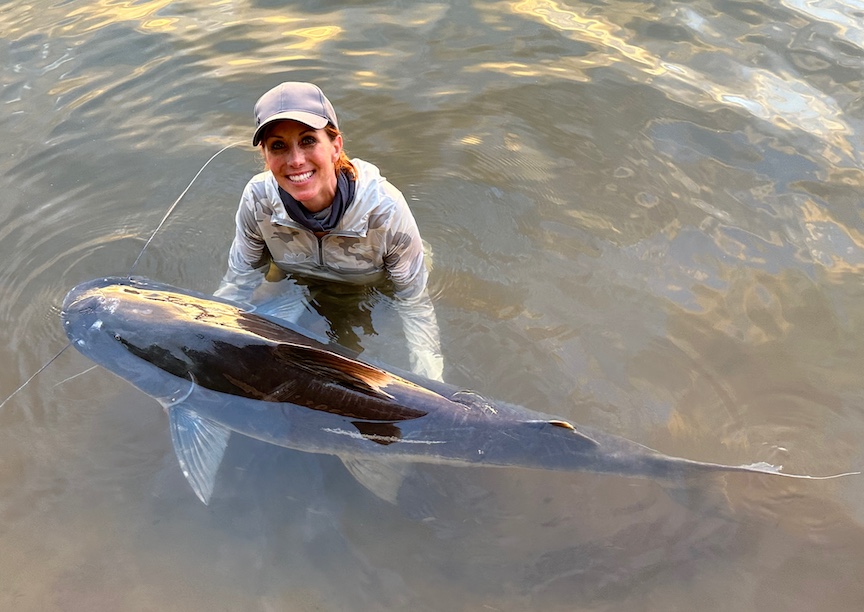
East-West News Service author Anietra Hamper in Guyana’s Essequibo River with a prized piraiba catfish. She is helping the fish recover from the fight and get it rested before releasing it. This is essential when it comes to responsible “catch and release” fishing. Photo by Ian Henderson
“The journey out is a silent one,” says Henderson. “You reflect on the fishing experience and, on a deeper level, your whole way of life. Each time I come here, the desire to return becomes even stronger.”
As anglers get closer to their river departure point in Fairview to catch the small aircraft back to Georgetown, the chorus of the howler monkeys fades into the distance. All the while, Mark maintains the same neutral demeanor he did when the anglers arrived. For him, life will go on tomorrow unchanged. For the anglers, their lives are forever altered.
But the experience they shared in this raw, wild, and innocent land has left in each a common desire to return someday to a jungle river that remains unblemished by change.![]()
Anietra Hamper is an award-winning writer and author specializing in outdoor adventure and fishing. She is a career investigative journalist and an EMMY-nominated television news Anchor.

